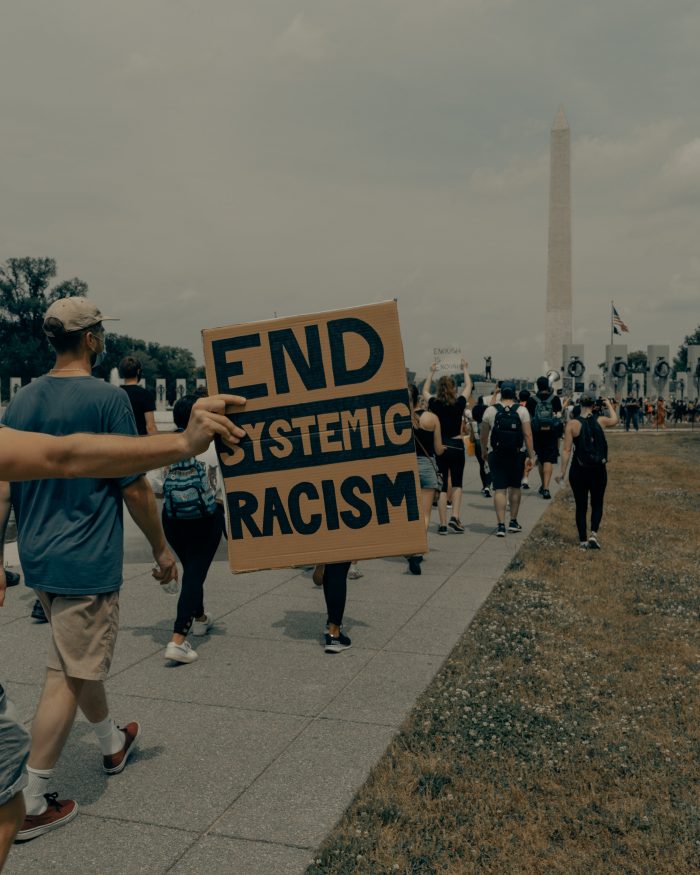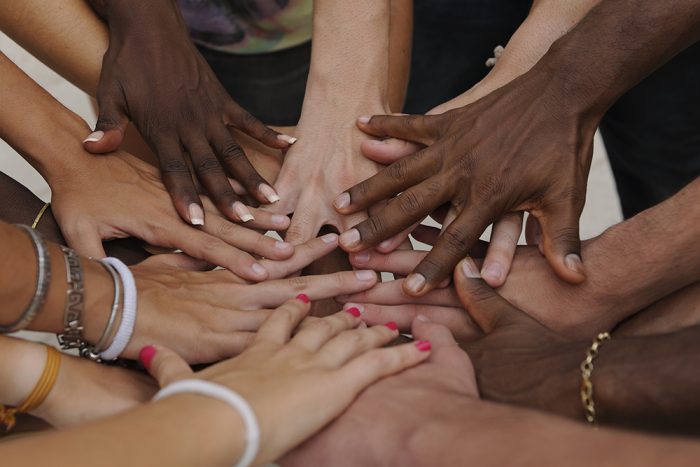Jack Phillips
DHS Racial Equity Action Kick-Off – Day Two

Good morning,
I hope that you’re all feeling well today and that you found yesterday’s readings helpful and informative. Today, we are going to talk about types of racism and how it can exist and persist even in today’s society. For some, the topic of race was never discussed, and for others, race has been inextricably linked to all parts of their lives. Some of us grew up learning that if we see people as people and do not “see color”, we will overcome racism. Unfortunately, while well-intended, we know today that that approach has not served people of color well. It’s important to understand how this perspective can create more challenges; these challenges are outlined in “Being ‘Color Blind’ Doesn’t Make You Not Racist—In Fact, It Can Mean the Opposite”. This article and all other articles from today are available here.
As yesterday’s readings taught, racial identity can deeply affect how a person experiences the world and how they are treated by the world. People of color cannot separate their racial identity from their lives, and disregarding that fact disregards how they experience the world. As I said yesterday, my experience as a woman is different from how a man experiences the world. In the same vein, we cannot remove race as a factor in how a person experiences the world.
Many of us are now learning how our own education on race and racism in post-Civil-Rights-Era America has not done enough to help us understand the nuances of how racism still persists throughout our country, systems, and communities today. This can happen both passively and actively. Through these conversations, there are often different types of racism discussed. Understanding these types is important to understanding how they present themselves and affect people in different ways. For now, I invite you to explore more about these different types of racism and how they intersect. The Aspen Institute defines these well, and “What is Systemic Racism and Institutional Racism?” breaks down how they play out in society.
As we progress through our educational journey, we must remember that people of color are not a monolith. They can in fact experience racism in different ways. Teaching Tolerance’s “What’s ‘Colorism’?” explains this varying dynamic.
As you read these resources, I encourage you to think about the following questions:
- How has your race influenced your sense of self?
- How were you taught about racism? Do you feel it adequately prepared you to identify and respond to racism?
- Has racism affected how you perceive your own community?
- What were your reactions to the four levels of racism? Do they match your understanding of racism?
- How do you see structural and institutional racism in the world today?
- Were you familiar with colorism? Have you considered how it may affect a person’s experience?
I also encourage you to have these conversations with your coworkers if you are comfortable and able to do so. This is an opportunity for us to learn together, share our experiences, foster understanding and community, and build stronger bonds through these difficult but extremely necessary conversations.
Remember that these articles are meant to be a foundation and introduction that you can build from. They are not the only sources and perspectives on these issues.
Talk to you tomorrow,
Teresa Miller, Secretary of the Department of Human Services
DHS Racial Equity Action Kick-Off – Day One
Good morning,
I hope you all had a good weekend! Today is the first day of the Department of Human Services’s (DHS’s) Racial Equity Action Kick-Off, and we’re going to start the week with a foundational overview on racial identity – how it is established and how it influences our lives. When you have time, please read the Summary of Stages of Racial Identity Development from the Racial Equity Tools website. That website is a wealth of information, and I highly encourage you to peruse their resources, particularly the Core Concepts as they give a strong overview that can help guide these conversations as we move forward. Another great source is The New York Times’s Conversations on Race Series. Through this series, you can learn about how race affects a person’s daily life directly from people of different races, ages, genders, and other varying perspectives that influence their experiences and world views.
Our social identities can shape our world view. How I experience the world as a woman is different from how a man experiences life and society. At the same time, how I experience the world as a white woman is different from how a woman of color experiences life and society. Recognizing that the experience of life is not “one size fits all” and that our identities shape our realities is critical in building empathy and understanding. Without empathy and understanding, we cannot progress. In addition to social identities, other factors can also influence our perspectives and experiences. Variables such as income and education level can, in some cases, serve as barriers for people and add to their personal challenges in life. You may be familiar with the term intersectionality – this term speaks to the interplay between social identities and barriers. Kimberlé Crenshaw, a scholar and professor at both the University of California at Los Angeles (UCLA) School of Law and Columbia Law School, gives an overview of intersectionality in an article included in 12.7 articles. There are also numerous other speeches and articles from her if you are interested in learning more.
I’m sure most of you have heard the term “white privilege” in the last couple of years. This term is one that people often misunderstand. White privilege does not assume that white people are exempt from struggles or challenges in life. Rather, the term works to point out the inequitable access to power, resources, and social currency that white people have in comparison to their black and brown equivalents. “What is White Privilege, Really?” from Teaching Tolerance (available in the 12.7 Articles PDF) details what privilege can mean, including how it affects people even if they do not feel that they experience privileges in their lives. If this term has been confusing or alienating, I encourage you to delve a little deeper because, in that discomfort, you may find an opportunity for learning, reflection, and empathy for others who do not have this privilege.
As you read and watch these resources, I encourage you to think about the following questions:
- What is a racial identity? How has my race impacted my life?
- How were my ideas and beliefs about race formed?
- Have you previously considered your own racial identity? If so, how? Do you feel your race influences your life? If no, what do you think your life would be like if that answer were yes?
- What is intersectionality? Am I impacted by intersectionality? If you are not, can you think of someone in your life who is impacted by intersectionality?
- Do you believe you have experienced privilege? Do you believe you have experienced marginalization? Has this ever affected your day-to-day life? Interactions?
I also encourage you to have these conversations with your coworkers as you are comfortable and able. This is an opportunity for us to learn together, share our experiences, foster understanding and community, and build stronger bonds through these difficult but extremely necessary conversations. Remember, these articles are meant to be a foundation and introduction that you can build from. They are not the only sources and perspectives on these issues.
Talk to you tomorrow,
Teresa Miller, Secretary of the Department of Human Services
PA Senate Democrats Call for $4 Billion COVID Relief Package Using Emergency Debt
On Friday, December 4, the Pennsylvania Senate Democrats introduced a state-level $4 billion COVID-19 pandemic relief proposal.
The Democrats’ proposal — titled the “Pennsylvania Coronavirus Aid, Relief, and Economic Security Act of 2021,” or “PA CARES 21” for short — aims to fund existing pandemic relief programs and establish new ones by taking out emergency debt and tapping into the state’s Rainy Day Fund. The proposal targets areas such as unemployment compensation, small business relief, education, and housing assistance.
If adopted, the Senate Democrats’ PA CARES 21 plan would fund the following by both allocating money toward existing programs and establishing new relief programs in previously unaddressed areas:
- $1 billion in unemployment benefits;
- $800 million in business assistance;
- $594 million in local government assistance;
- $411 million toward education (including higher education, Pre-K, and basic education);
- $318 million toward Department of Human Services programs;
- $180 million in transportation funding;
- $135 million toward hazard pay;
- $100 million in housing assistance;
- $100 million toward hospitals;
- $100 million in utility assistance;
- $75 million toward child care;
- $50 million toward food security efforts;
- $25 million for personal protective equipment and vaccines; and
- $15 million in mental health funding.
Senate Democrats hope to begin negotiating the details of the package as soon as possible, but it may experience heavy resistance from Senate Republicans, who have the majority in the Senate.
DDAP Announces Webinar/Meeting Opportunities
Problem Gambling Webinar: Sports Betting and Online Gambling
- Thursday, December 10, 2020 from 11:00 am – 1:00 pm
- This training will explore the nature of problem gambling while examining emerging trends in online gambling, sports betting, and future considerations in Esports wagering. See this flyer for more details.
Veterans Benefits Administration Tele-Townhall
- See this webpage for upcoming dates, times, and call-in information.
- The Tele-Townhall series is hosted by the US Department of Veterans Affairs, Veterans Benefits Administration (VBA) Under Secretary for Benefits, Dr. Paul Lawrence.
Conversation with the Department of Drug and Alcohol Programs (DDAP) – Part 2: Collaboration Opportunities for County Jails and Opioid Treatment Programs to Support and Expand Medications for Opioid Use Disorder (MOUD) Services
- Wednesday, December 9, 2020 from 1:00 pm – 2:00 pm
- This conversation will discuss options to increase medications for opioid use disorder in the jail system by working closely with local Opioid Treatment Programs (OTP). Topics will include OTP regulations relevant to jails and opportunities to increase access to methadone within jails.
- Recommended Participants:
- Lead representatives from grantee jails, including members of clinical, custody, and administration teams who support data collection, reporting, and evaluation of MOUD programs
- Representatives from state OTPs
- State correctional institutions and non-grantee jails are also encouraged to participate if interested in learning more about MOUD and future grant opportunities
For more information, please contact Mary Kate Brousseau.
DDAP Announces Federal Resources and Funding Opportunities
Workshop Series
- Reminder: The Office of National Drug Control Policy has launched a new workshop series for rural faith leaders. It is entitled Empowering Faith Leaders to Help Persons with Substance Use Disorder. This is a series of four workshops that will allow rural faith leaders to share valuable information and resources. The first workshop, Substance Use Disorder and the Pandemic in Rural Communities, will take place on December 8, 2020 from 1:00 pm – 2:30 pm Eastern Standard Time. If you would like to attend, RSVP to Betty-Ann Bryce. Please include your name, title, organization, and contact information.
Funding
- The Department of Health and Human Services – Substance Abuse and Mental Health Services Administration (SAMHSA), Center for Mental Health Services (CMHS) is accepting applications for the fiscal year (FY) 2021 Statewide Family Network grant program (SFN). The purpose of this program is to more effectively respond to the needs of children, youth, and young adults with serious emotional disturbances (SED) and their families by providing information, referrals, and support; it will also create a mechanism for families to participate in state and local mental health services planning and policy development. The application due date is January 4, 2021.
- The Department of Health and Human Services – Substance Abuse and Mental Health Services Administration (SAMHSA), Center for Mental Health Services (CMHS) is accepting applications for the fiscal year (FY) 2021 Statewide Consumer Network grant program (SCN). The purpose of this program is to improve efforts to address the needs of adults with serious mental illness (SMI) by developing and/or expanding peer support services, peer leadership, and peer engagement strategies statewide. The application due date is January 4, 2021.
- The Department of Health and Human Services – Health Resources and Services Administration (HRSA) Behavioral Health Workforce Education and Training (BHWET) Program for Professionals aims to increase the supply of behavioral health professionals while also improving distribution of a quality behavioral health workforce, thereby increasing access to behavioral health services. A special focus is placed on the knowledge and understanding of children, adolescents, and transitional-aged youth at risk for behavioral health disorders. The closing date is January 21, 2021.
- The Department of Health and Human Services announces the opportunity to apply for funding under the National Telehealth Resource Center (NTRC) Program. The purpose of NTRCs is to support the delivery of telehealth technical assistance through Regional Telehealth Resource Centers (RTRCs). Two NTRCs may be funded. The closing date is January 21, 2021.
- The Department of Health and Human Services announces the opportunity to apply for funding under the Regional Telehealth Resource Center (RTRC) Program. RTRCs assist health care organizations, health care networks, and health care providers in the implementation of cost-effective telehealth programs to serve rural areas and populations. RTRCs also assist patients and families living in rural areas with telehealth technology so that they can obtain health services. This notice of funding opportunity (NOFO) will support 12 RTRCs that focus on statewide and regional telehealth activities. The closing date is January 21, 2021.
- The Department of Health and Human Services announces the opportunity to apply for funding under the Rapid Response Rural Data Analysis and Issue Specific Rural Research Studies Program. The purpose of this program is to assist rural communities with conducting rapid data analyses and short-term issue-specific rural research studies to understand the impact of current and proposed policies and regulations as well as provide information that will improve health care in rural America. The closing date is January 29, 2021.
Department of Health Announces New App: COVID Alert PA
The Pennsylvania Department of Health, along with Apple and Google, has launched an exposure notification app called COVID Alert PA. It is available to download for free at the Apple App Store and Google Play Store.
The app is an effective tool, but the commonwealth needs your help getting it in the hands of Pennsylvanians. We need help getting the word out – and downloads up.
Can you help us? We have an extensive catalog of marketing materials, including posters, social media posts, press releases, and other customizable content. You can find downloadable marketing materials on the Community Resources webpage.
COVID Alert PA is a free mobile app that uses Bluetooth Low Energy (BLE) technology and the Exposure Notification System developed by Apple and Google. Features include:
- Interactive COVID-19 symptom checker;
- Opt-in for alerts concerning potential exposure to the virus;
- Updates on the latest public health data about COVID -19; and
- Language options available in English, Spanish, German, and traditional Chinese.
COVID Alert PA protects both privacy and personal information. The app does not use GPS, location services, or any movement or geographical information. It will never collect, transmit, or store personal information. It is completely anonymous.
Thank you in advance for helping to get the word out to your employees, customers, family, friends, and neighbors.
Thank you for your support!
Wolf Administration Reminds Pennsylvanians Experiencing Anxiety, Loneliness, Stress During the Holiday Season that They Are Not Alone
DDAP Announces 2020 Compulsive and Problem Gambling Annual Report
The Department of Drug and Alcohol Programs (DDAP) is pleased to release the 2020 Compulsive and Problem Gambling Annual Report.
This report details the impact of programs funded by the Compulsive and Problem Gambling Treatment Fund, including Single County Authority on Drug and Alcohol (SCA) funding; gambling treatment provider funding; and oversight of programs, trainings, and helpline services.
COVID Vaccine Could Be Ready for Rollout in Pennsylvania Next Month, Health Secretary Says













